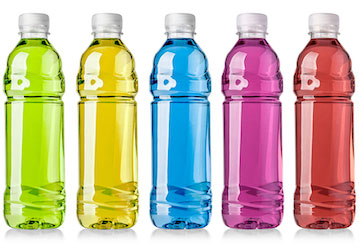Sports drinks are fluid-replacement beverages that contain water, carbohydrates, and electrolytes. They can be a quick and convenient way to hydrate and fuel for optimal exercise performance. The following tips can help you decide if you need a sports drink for exercise and how to choose the right one.
Do I need a sports drink?
The best way to meet your fluid and electrolyte needs is to drink water and eat regular meals and snacks throughout the day. However, a sports drink might be helpful during or after activity (or both), under certain circumstances:
- Sustained exercise that lasts longer than 60 minutes
- Exercise in extreme environments, such as high heat and humidity
- When limited options prevent you from hydrating and fueling appropriately, such as during deployments or training
In these instances, sports drinks support optimal exercise performance by providing a fuel source and replacing fluids and electrolytes lost in sweat.
What nutrients are important in sports drinks?
- Fluid helps you stay hydrated, which is essential to performance. Losing just 2% of your body weight from dehydration negatively affects your physical and mental performance. Sports drinks provide fluid to support exercise, but it’s important to follow basic hydration strategies to ensure you meet your fluid needs throughout the day.
- Carbohydrates provide a quick source of energy to your muscles and help maintain your blood sugar. If you consume sports drinks only for taste and not to support exercise performance, keep in mind they might be adding unnecessary sugar and calories to your diet.
- When you sweat, sodium is the main electrolyte you lose. You need sodium to help retain fluid, and it stimulates your thirst.
- Potassium—which supports hydration and helps maintain muscle contractions—is another electrolyte you lose in sweat, but not to the same extent as sodium.
What should my sports drink contain?
For every 8 ounces, a sports drink should contain:
- Carbohydrates: 12–24 g
- Sodium: 82–163 mg
- Potassium: 18–46 mg
Many commercial sports drink products are designed to meet these fueling guidelines. Ingredients vary among products, so be sure to double check the Nutrition Facts label for nutrient information. Be careful with products that contain higher amounts of carbohydrates and sodium, as they might upset your stomach.
Other ingredients and nutrients are frequently added to sports drinks—such as extra vitamins, minerals, or amino acids—but they don’t offer immediate benefits to your exercise performance. If you worry about meeting your needs for some of these nutrients, focus on eating well-balanced meals and snacks instead. Also look out for added caffeine.
Make your own
Use this simple recipe to make your own sports drink:
- ¼ c sugar or honey
- ¼ tsp salt
- ¼ c hot water
- ¼ c orange juice
- 2 Tbsp lemon juice
- 3½ c cold water
Dissolve the sugar and salt in the hot water. Add the juice and the remaining water. Drink or chill if preferred. Makes one quart.
Nutrition per 8 oz: 50 calories, 12 g carbohydrates, 110 mg sodium, 40 mg potassium
For more information, HPRC provides a handout on hydration beverages to help you choose the right drink to meet your needs. When you follow proper nutrient timing guidelines, you can experiment with different fuel and hydration options to support your exercise performance.
